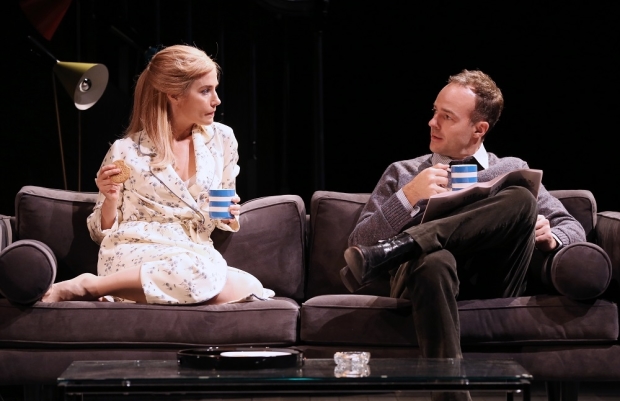
(© Carol Rosegg)
The Shakespeare Theatre Company is giving new life to two of Harold Pinter's early plays: The Lover, written in 1962, and The Collection, written in 1961, in this double-bill production. Precisely acted and intelligently directed by Michael Kahn, the plays show how Pinter created a unique, non-naturalistic style in order to write about relationships between men and women and men and men.
The Lover is set in the 1960s in a suburb of London. It begins with a quick scene between a husband, Richard, and wife, Sarah, in which he asks if her lover is coming that day. She replies in the affirmative. He leaves for work. Sarah spends the day readying herself for her lover. She puts on a form-fitting dress and high heels and practices undulating moves, making even the simple act of sitting on a couch look like a sexual invitation. When her lover (whom she calls Max) does arrive, he is, in fact, Richard, playing a character. As part of their role-playing game, they discuss how her husband and his wife can stand the fact that their spouses have lovers. They invent facts, teasing each other with details about those lovers. Finally, Richard says he wants to stop the pretended infidelity, but Sarah objects and Richard resumes his role as Max.
Patrick Kennedy is excellent as Richard, a buttoned-up London businessman who becomes his antithesis, a casually dressed, bongo-playing, sexually predatory male, when visiting Sarah as "Max." Kennedy plays both roles to perfection. Lisa Dwan is equally compelling as Sarah. The scene where she prepares for the arrival of her lover — especially the exaggerated motions she goes through to sit — provide the most memorable comedic moments in the play.
The Collection features four characters: James and his wife, Stella, a dressmaker, both in their 30s; Harry, a high-end antiques dealer in his 40s; and his companion Bill, a dressmaker in his 20s. Early on in the play, James confronts Bill, claiming that his wife has confessed that she had a one-night stand with Bill when they were at a dressmakers' convention out of town. At first Bill denies everything, but slowly his version of events changes. Ultimately, he says he and Stella sat in the lounge of their hotel and talked for two hours about what they would do when they got to Stella's room.
Patrick Kennedy is brilliant as James, the man who is obsessed by his wife's confession and needs to meet the man who may or may not have cuckolded him. Lisa Dwan is superb as Stella, who still represents an emotionally unattainable lover for James even though she is his wife. Patrick Ball is delightful as Bill, a vain young man who tries to control James by continually changing his story. Jack Koenig's Harry offers a new perspective to the situation: When he hears of Stella's accusation, Harry tries to control the narrative by visiting Stella, lying to James, and viciously chastising Bill for having a "slum mind." Harry's actions primarily reveal his jealousy of Bill's possible infidelity.
Kahn emphasizes both plays' humor as well as the mercurial nature of Pinter's philosophy. One moment, nothing matters; the next moment, everything does. Debra Booth creates one set for The Lover, showing Richard and Sarah's living room, dining area, and front door downstage, and creates a bedroom on a raised platform. For The Collection, she constructs two homes on one stage: Harry's Georgian row house, full of expensive furniture and Chinese porcelains, and James and Stella's Chelsea flat, furnished with contemporary furniture, including a blond wood record player and a 1960s bullet floor lamp. Lighting designer Mary Louise Geiger's blackouts, which are essential to both plays and Pinter's style of storytelling, are crisp and often as important as the text. Costume designer Jane Greenwood dresses both casts in clothes typical of the early 1960s.
The Lover and The Collection are excellent examples of Pinter's fascination with the dynamics between the sexes and his feeling that it is impossible to fully know the inner workings and desires of another human being. The Shakespeare Theatre Company productions of these two plays show precisely how Pinter wanted audiences to experience these dynamics in a sexually charged world where deception runs rampant, other people are uncontrollable, and nothing is really as it seems.








